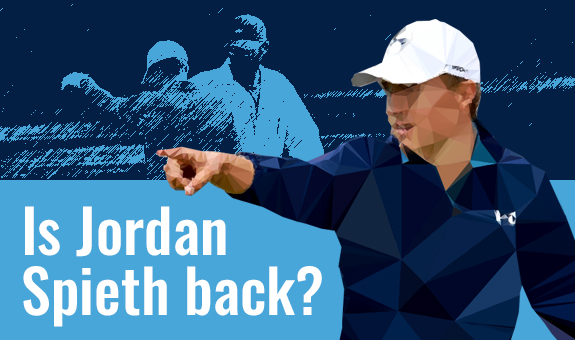When we were brainstorming ideas for this piece a couple of weeks ago, the
question posed in the title was more open for debate than it is now.
If anything, declaring that Spieth had returned to his previous form still seemed premature.
But after his win last week to end a victory drought that spanned nearly four years,
it seems like there is no denying that Spieth is, at least in some sense, “back”.
The feeling is heightened by Spieth’s return this week to a place where he’s had some of his greatest successes.
Media and betting markets are making Spieth one of the favourites (and in some cases “the” favourite) to win this week.
There’s no doubt it’s full steam ahead on the Jordan Spieth hype train as we roll into the 2021 Masters.
However, it’s easy to forget how good Spieth once was.
It’s also easy to forget what it means to be the best player in the world at any given moment.
At his peak in 2015, Spieth was gaining nearly 3 strokes per round over an average PGA Tour player for the better part of a year.
Jon Rahm, who currently sits atop our player rankings,
has been averaging 2.4 strokes better per round
than the average pro for the last 3 years.
Since Spieth’s current resurgence started in early February at the Phoenix Open, he’s averaged +2.37 (true) strokes-gained per round.
These are solid performances but not other-worldly, as the context provided above demonstrates.
Further, even restricting our comparisons to the present moment,
Spieth’s performance over the last 2 months have been bettered by 4 golfers and he is followed closely by 5 others.
(However, of these 10 golfers Spieth does have the most rounds played — 28 — in the time period under consideration.)
Therefore it seems our headline question requires some elaboration: if Spieth is back, what state is Spieth back to?
Is it the once-in-a-decade form he flashed in the summer of 2015?
The less heralded, but hardly less impressive, form in late 2017?
Or are we making a weaker claim, which is just that Spieth has extricated himself
from a slump that started in 2019 and showed no signs of going away to start 2021?
In this article we display some data at the level of individual shots in an attempt to
understand which past version of Jordan Spieth the current one most closely resembles.
At this point it might be useful to pull up
Spieth’s true strokes-gained page if you
want the additional context of more aggregated strokes-gained data.
But, in case you’d prefer to continue enjoying the full screen experience of a Data Golf blog,
we’ll provide the necessary context here in the text, too.

 Analytics Blog
Analytics Blog PUBLISHED April 6, 2021
NIGHT MODE
DAY MODE

Is Jordan Spieth Back?
A statistical deep-dive into Spieth's turbulent career
DRIVING
To begin, naturally, we’ll start at the tee.
During the peak-Spieth years, Jordan put up solid strokes-gained numbers with the driver, averaging between 0.4 and 0.6 strokes-gained per round in each season from 2015-2018.
(And actually had his best year off the tee in 2013, averaging +0.67 strokes-gained in the category.)
In recent seasons however, as Spieth Truthers know all too well, Jordan has struggled mightily with the Big Stick.
The plot below displays the ending location of all of Spieth’s drives since 2010 on an x-y coordinate system, where the x-axis is yards from the middle of the fairway and the y-axis is distance from the tee. The orange lines indicate the average x and y values for the highlighted time period.
The plot below displays the ending location of all of Spieth’s drives since 2010 on an x-y coordinate system, where the x-axis is yards from the middle of the fairway and the y-axis is distance from the tee. The orange lines indicate the average x and y values for the highlighted time period.
DRIVING DISPERSION PLOT
—
Spieth’s career off-the-tee has shown three separate minor peaks.
During the first two, in late 2013 and late 2015,
Spieth was only averaging about 285 yards off the tee,
but his left-right dispersion was
pretty tight (throughout the article, click the orange text to alter the plots to display the relevant data).
Interestingly, the dispersion in distance for his tee shots also seemed to be much lower earlier in his career.
During the third peak, occurring in late 2017 to early 2018,
Spieth was nearly 10 yards longer with the driver at 295 yards, and had only sacrificed slightly in the accuracy department.
Since then Spieth has experienced a precipitous drop in accuracy.
Even during this recent surge in overall performance,
Spieth has never been less accurate off the tee than he is now.
APPROACH
It’s been well documented by members of the golf intelligentsia that
Spieth’s approach game was an underrated contributor to his past success.
For casual observers of the game,
it often fell in the shadow of his silky long-range putting stroke.
But Spieth really was an elite iron player for the better part of 5 years beginning in late-2013, and was possibly the best on the planet in the category for most of 2017.
However, in late 2018, Spieth’s approach game started to decline, and by mid-2020 he was performing below the level of
an average tour PGA Tour professional. This from a guy who was the best in the world with an iron in his
hand as recent as 2017.
So, what happened?
The plot below shows Spieth's strokes-gained on every Shotlink-measured approach shot since 2010 (with some shots types filtered out, e.g. punch outs). Also shown is the 100-shot moving average to help identify any trends over time; be sure to use the toggle to hide the raw data on the top right of the plot. Finally, the benchmarks in the right sidebar indicate the typical average SG value in a season for golfers of various rankings in the selected yardage bucket.
The plot below shows Spieth's strokes-gained on every Shotlink-measured approach shot since 2010 (with some shots types filtered out, e.g. punch outs). Also shown is the 100-shot moving average to help identify any trends over time; be sure to use the toggle to hide the raw data on the top right of the plot. Finally, the benchmarks in the right sidebar indicate the typical average SG value in a season for golfers of various rankings in the selected yardage bucket.
TRUE SG APPROACH
150 - 175 YARDS
blackwhite line shows 100-shot moving average
MOVING AVG ONLY
BENCHMARKS
BEST
TOP 5
TOP 10
TOP 25
TOP 50
TOP 100
At various points in his career Spieth has excelled from different distances.
Most of the variation is probably noise, but it appears
that earlier in his career Spieth made his hay from under 150 yards, while
the 2017 season was driven mainly by his performance with the longer irons.
The downturn in Spieth’s approach
performance beginning in 2019 could be seen pretty much across the board,
but looks most noticeable in the 100-150 range.
In the last two months Spieth’s approach game has been close to the best in the game. Interestingly, the uptick has occurred without much good happening in the 75-150 yard buckets. However Spieth has made up for that with the mid-to-long irons, performing at the level of the best in the world in both the 150-175 and 175-200 yardage buckets.
The next plot displays Spieth’s approach shots on an x-y coordinate system centered on the pin location. You can filter shots by pin placement using the buttons above the plot, and by origin (fairway or rough) using the toggle in the top left.
In the last two months Spieth’s approach game has been close to the best in the game. Interestingly, the uptick has occurred without much good happening in the 75-150 yard buckets. However Spieth has made up for that with the mid-to-long irons, performing at the level of the best in the world in both the 150-175 and 175-200 yardage buckets.
The next plot displays Spieth’s approach shots on an x-y coordinate system centered on the pin location. You can filter shots by pin placement using the buttons above the plot, and by origin (fairway or rough) using the toggle in the top left.
APPROACH DISPERSION PLOT
—
FAIRWAY/TEE SHOTS ONLY
PIN PLACEMENT
PIN PLACEMENT
This data is fun to sift through but it is hard to have any firm takeaways.
One interesting thing we noticed is that early on in Spieth’s career, and during his
better years of iron play, he was less likely to be short when
hitting into back pins.
Focusing on fairway/tee shots in the 125-175 range (but this pattern holds true for all buckets and shot origins),
Spieth’s average approach to back pins hovered between 2-6 feet short.
In the 2019 and 2020 seasons this average fell as
low as 10 feet short of the pin.
Since September 2020 that has climbed back up to just 5 feet,
but at this point we really are cherry-picking dates and yardage bins,
so explore it for yourself!
PUTTING
Spieth’s putting was the
first part of his game
to show a decline as he
went from being one of the best putters on tour through the 2014-2017 seasons to a below-average putter by mid-2018.
It’s possible that this cold spell with the flat stick ultimately bled into other facets of his game.
Spieth experienced a somewhat heroic rebound on the greens in 2019 while the rest of his game was in shambles.
It is scary to think how low the depths could have been if his putting hadn’t buoyed him during that season.
Shown next is the strokes-gained plot for all of Spieth's putts since 2010.
Shown next is the strokes-gained plot for all of Spieth's putts since 2010.
TRUE SG PUTTING
10 - 20 FEET
blackwhite line shows 100-putt moving average
MOVING AVG ONLY
BENCHMARKS
BEST
TOP 5
TOP 10
TOP 25
TOP 50
TOP 100
It’s clear that Spieth has never been great from short range.
When he first came out on tour he was really shaky from 3-5 feet,
which is not surprising given he was looking at the hole
frequently inside that distance (we aren’t taking a stand on the direction of causation here).
He did however manage to get it together during his peak years and
was above average for several seasons.
In early 2019 Spieth’s short putting took a turn for
the worse that
perhaps only Ernie
could appreciate ( Trigger Warning: link contains graphic content which may be unsuitable for some golfers).
More recently Spieth has hovered around the tour average from the short distances.
Spieth was known best for pouring in mid-distance daggers with relative ease during his prime, and the data does reveal he was unmatched in that range for several years. It was also this range that showed the biggest decline in 2018, helping fuel the narrative that something was “wrong with Jordan” before his ball-striking had even begun to deteriorate. In the last two years Spieth has returned to his old self from this distance. It’s interesting to note how much less noise there is in putting performance from the longer distances. For math-oriented readers this should be easy to understand: for a binary (1 or 0) variable, the variance is maximized when the probability of success is 50%, which for putting occurs around 8 feet. Spieth has been above average from beyond 30 feet pretty much his entire career (using the 100-putt moving average), while his performance from 10-20 has fluctuated wildly.
Spieth was known best for pouring in mid-distance daggers with relative ease during his prime, and the data does reveal he was unmatched in that range for several years. It was also this range that showed the biggest decline in 2018, helping fuel the narrative that something was “wrong with Jordan” before his ball-striking had even begun to deteriorate. In the last two years Spieth has returned to his old self from this distance. It’s interesting to note how much less noise there is in putting performance from the longer distances. For math-oriented readers this should be easy to understand: for a binary (1 or 0) variable, the variance is maximized when the probability of success is 50%, which for putting occurs around 8 feet. Spieth has been above average from beyond 30 feet pretty much his entire career (using the 100-putt moving average), while his performance from 10-20 has fluctuated wildly.
CONCLUSION
The biggest difference between slumping Spieth and prime Spieth is his ball striking.
This recent return to form has been driven more by Spieth's approach game than his putting,
which is probably the most encouraging thing about it.
That being said, it does seem like Spieth’s mojo on the greens is
returning after he went on what
can only be described as Spieth-like runs
from outside 30 feet at the
Phoenix Open and Arnold Palmer Invitational earlier this year.
Ultimately, if Spieth wants to reach his previous heights he still needs to figure out the driver. He has shown signs of life off the tee in the last two months, both anecdotally — hitting some big drives with little margin for error under pressure (his drive on the 10th at Pebble with the tees up comes to mind), and statistically — he has gained (a small amount of) strokes off the tee in each of his last 5 events. As good as the rest of Jordan Spieth’s game might be right now, you just can’t be giving up a full stroke per round off the tee to a guy like Jon Rahm and expect to come out on top consistently.
What should we expect from Spieth this week? Augusta National is a course that emphasizes the skills that Spieth possesses (a good short-game, and to a lesser degree distance) and downplays the skills he doesn’t (driving accuracy). Looking back on our estimates of Spieth’s skills prior to the 2015 Masters, it’s interesting to note that he is actually a better fit for the course now. In 2015 Spieth was more well-rounded than he is today: he was above average in every attribute, including driving accuracy. Even though overall Spieth is likely a worse golfer today than he was in early 2015, that difference should shrink on a course like Augusta National.
It's hard to believe given where he was just two months ago, but with a little luck this could be the week Jordan Spieth gets his second Green Jacket.
Ultimately, if Spieth wants to reach his previous heights he still needs to figure out the driver. He has shown signs of life off the tee in the last two months, both anecdotally — hitting some big drives with little margin for error under pressure (his drive on the 10th at Pebble with the tees up comes to mind), and statistically — he has gained (a small amount of) strokes off the tee in each of his last 5 events. As good as the rest of Jordan Spieth’s game might be right now, you just can’t be giving up a full stroke per round off the tee to a guy like Jon Rahm and expect to come out on top consistently.
What should we expect from Spieth this week? Augusta National is a course that emphasizes the skills that Spieth possesses (a good short-game, and to a lesser degree distance) and downplays the skills he doesn’t (driving accuracy). Looking back on our estimates of Spieth’s skills prior to the 2015 Masters, it’s interesting to note that he is actually a better fit for the course now. In 2015 Spieth was more well-rounded than he is today: he was above average in every attribute, including driving accuracy. Even though overall Spieth is likely a worse golfer today than he was in early 2015, that difference should shrink on a course like Augusta National.
It's hard to believe given where he was just two months ago, but with a little luck this could be the week Jordan Spieth gets his second Green Jacket.